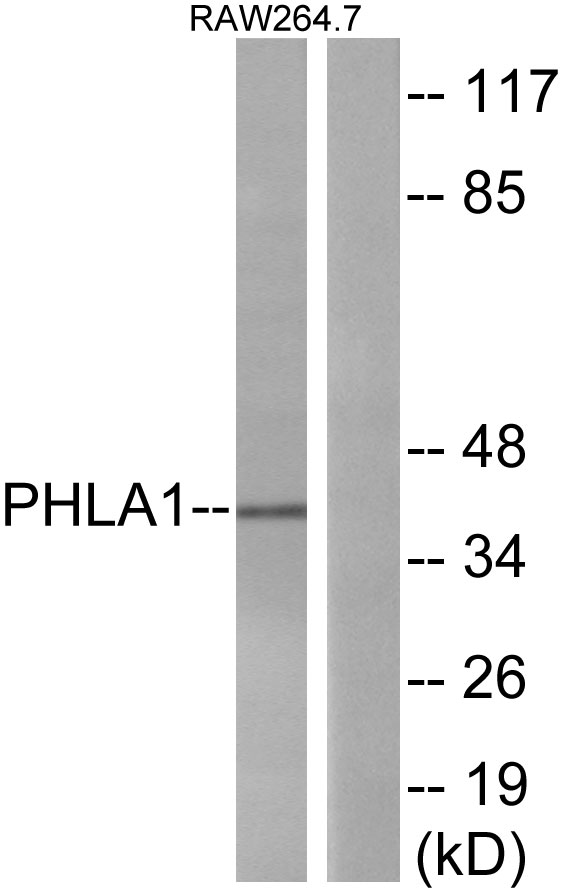TDAG51 Polyclonal Antibody
- Catalog No.:YT4590
- Applications:WB;ELISA
- Reactivity:Human;Mouse;Rat
- Target:
- TDAG51
- Gene Name:
- PHLDA1
- Protein Name:
- Pleckstrin homology-like domain family A member 1
- Human Gene Id:
- 22822
- Human Swiss Prot No:
- Q8WV24
- Mouse Gene Id:
- 21664
- Mouse Swiss Prot No:
- Q62392
- Rat Swiss Prot No:
- Q9QZA1
- Immunogen:
- The antiserum was produced against synthesized peptide derived from human PHLA1. AA range:271-320
- Specificity:
- TDAG51 Polyclonal Antibody detects endogenous levels of TDAG51 protein.
- Formulation:
- Liquid in PBS containing 50% glycerol, 0.5% BSA and 0.02% sodium azide.
- Source:
- Polyclonal, Rabbit,IgG
- Dilution:
- WB 1:500 - 1:2000. ELISA: 1:10000. Not yet tested in other applications.
- Purification:
- The antibody was affinity-purified from rabbit antiserum by affinity-chromatography using epitope-specific immunogen.
- Concentration:
- 1 mg/ml
- Storage Stability:
- -15°C to -25°C/1 year(Do not lower than -25°C)
- Other Name:
- PHLDA1;PHRIP;TDAG51;Pleckstrin homology-like domain family A member 1;Apoptosis-associated nuclear protein;Proline- and glutamine-rich protein;PQ-rich protein;PQR protein;Proline- and histidine-rich protein;T-cell death-associated
- Observed Band(KD):
- 40kD
- Background:
- This gene encodes an evolutionarily conserved proline-histidine rich nuclear protein. The encoded protein may play an important role in the anti-apoptotic effects of insulin-like growth factor-1. [provided by RefSeq, Jul 2008],
- Function:
- function:Seems to be involved in regulation of apoptosis. May be involved in detachment-mediated programmed cell death. May mediate apoptosis during neuronal development. May be involved in regulation of anti-apoptotic effects of IGF1. May be involved in translational regulation.,induction:Induced by homocysteine and other ER stress-inducing reagents. Induced by phorbolester (TPA)/ionomycin, and stimulation of the T-cell receptor (TCR) complex in T-cells.,similarity:Contains 1 PH domain.,subcellular location:Colocalizes with intracellular vesicles.,subunit:Interacts with RPL14, EIF3S7 and PABPC4.,tissue specificity:Widely expressed with highest levels in pancreas. Strongly expressed by benign melanocytic nevi, and progressively reduced expressed in primary and metastatic melanomas (at protein level).,
- Subcellular Location:
- Cytoplasm . Cytoplasmic vesicle . Nucleus, nucleolus . Colocalizes with intracellular vesicles. .
- Expression:
- Widely expressed with highest levels in pancreas. Strongly expressed by benign melanocytic nevi, and progressively reduced expressed in primary and metastatic melanomas (at protein level).
- June 19-2018
- WESTERN IMMUNOBLOTTING PROTOCOL
- June 19-2018
- IMMUNOHISTOCHEMISTRY-PARAFFIN PROTOCOL
- June 19-2018
- IMMUNOFLUORESCENCE PROTOCOL
- September 08-2020
- FLOW-CYTOMEYRT-PROTOCOL
- May 20-2022
- Cell-Based ELISA│解您多样本WB检测之困扰
- July 13-2018
- CELL-BASED-ELISA-PROTOCOL-FOR-ACETYL-PROTEIN
- July 13-2018
- CELL-BASED-ELISA-PROTOCOL-FOR-PHOSPHO-PROTEIN
- July 13-2018
- Antibody-FAQs
- Products Images

- Western Blot analysis of RAW264.7 cells using TDAG51 Polyclonal Antibody

- Western blot analysis of lysates from RAW264.7 cells, using PHLA1 Antibody. The lane on the right is blocked with the synthesized peptide.



